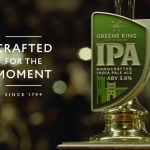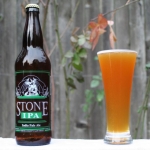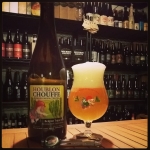In some ways, brewing fine beer is like playing an old Jazz standard; you have the basic template in front of you, but it is the musician’s choice to play it as faithfully to the original score as possible, or to improvise such that the initial footprint of the song is hardly recognizable. Within the world of craft beer today, some brewers take an old, tried and tested style—India Pale Ale, Schwarzbier, Saison, etc.—and brew it as faithfully to the traditional style as they can, while others use the style as merely a baseline, riffing off the original but adding their own personal twist. This is what makes ‘the craft beer revolution’ so exciting: even within the same style, no two beers are alike.
Today, we’re going to look at three India Pale Ales, or IPA’s, to illustrate the diversity of flavor profiles even within a given beer style. India Pale Ale harkens back to the days of the British Empire, and was itself a staple of Britain’s control over India. Hops are a natural preservative, and when you’re sailing halfway around the world, well, you’re going to need a boatload. English brewers added more hops than they’d previously done when preparing beer to go out on the high seas for months on end, thus giving birth to the heavily-hopped style, India Pale Ale.
Greene King ipa
Seeing as the style originated there, let’s start off in England, with Greene King IPA. This beer is, fittingly, brewed with all English hops, Challenger, Pilgrim, and First Gold, all of which have moderate alpha acid contents, ranging between 6 – 13 %. It pours a burnt caramel color, and while there is some hop aroma, and a bit of hop bitterness on the palate, it’s a fairly smooth, easy-drinking IPA; and at 3.6% alcohol, it won’t bowl you over. This is a quintessential example of what’s now known as “English IPA,” a style with a bit of dark malt, a notable hop presence, but a balance on the palate, and an ABV that keeps it a distinctly sessionable beer.
Stone IPA
Across the Atlantic, however, IPA looks very, very different. Although the US craft beer scene has a diversity of IPA’s on offer—and although a great many breweries in the Midwest and on the East Coast would beg to differ—the American IPA is often defined by its West Coast iterations. And among West Coast IPA’s, Stone IPA is both an old stalwart, and still a standout. The folks at Stone began brewing commercially in 1997, and have been at the forefront of California’s beer scene ever since. Stone IPA uses Magnum Hallertau, Chinook, and Centennial hops, all of which average higher alpha acid contents than the three hops used in Greene King. Consequently, the IBU rating of Stone IPA is much higher: 77, roughly twice that of Greene King. And the alcohol? It’s nearly doubled up as well, clocking in at 6.9% ABV.
Stone IPA pours a much lighter color than Greene King, a golden hue with just a touch of amber. In this brew, malt is definitely on the back-burner. Some critics of West Coast IPAs cite their low malt profile, arguing that the light malts don’t have the heft of darker malts, and thus can’t balance out the bitterness of the hops. Is this an unbalanced beer? Well, perhaps, but that’s really not the point; Stone, as with most West Coast IPA’s, is all about hops, and the light malt quality lets the citrusy hop aroma take center stage.
Welcome to the Chimera: Houblon Chouffe Dobbelen IPA Tripel
From what might be considered quintessential examples of English and West Coast IPAs, we now head to Belgium for something completely different, a hybridized beer from Brasserie d’Achouffe. This beer combines the traditional English IPA with the intensely hopped, high ABV American IPA, but does so through the lens of Chouffe’s head brewer’s flagship and favorite style: a Belgian Tripel.
The hops used here come from both Europe and the US, Tomahawk in the brew kettle, Saaz near the end of the boil, and Amarillo to dry-hop. The IBU’s are right between our previous two beers at 59, and the hop aroma is distinct yet subtle. On the palate, this beer is, truly, a hybrid; it has the dry-hopped citrus notes of an IPA, but also the dryer, light crisp estery fruitiness of a Tripel. The mouthfeel is closer to a standard Belgian Tripel, but the finish retains the strong hop characteristic of an American IPA. Don’t try to pigeonhole this brew into a single category; but do go out and get some to experience this chimera for yourself.
Down the Rabbit Hole
These three IPA’s are all remarkably different, yet each holds claim—and rightfully so—to the title of India Pale Ale. But this is just the tip of the iceberg. What about Bell’s Hopslam, a Double IPA brewed with honey? Or Elysian’s Avatar, a West Coast IPA brewed with Jasmine flowers? Brew Dog’s Hardcore and Punk IPA’s, reinventing the UK’s IPA with an American twist? And don’t even get us started on Thomas Creek’s Chocolate Orange IPA.
Whether you love hops or can’t stand the bitterness, go crazy over an imperial, barrel-aged stout or only get down with a drinkable, session lager, the craft beer world’s multifaceted brews have something for you. Sometimes experiments fail (I recently brewed a scotch ale aged with dried cherries that was too tannic to touch), and sometimes the new spin on an old style seems a useless attempt to fix what ain’t broke. But innovation is key to any industry, and in today’s world of craft beer, from one style to the next or even within one, innovators abound.


